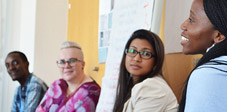Indigenous peoples come together to discuss effective engagement with the UN human rights system
.jpg) ISHR hosted a panel discussion in New York on May 14, 2012 on “The International Human Rights Framework: Opportunities and Challenges for Indigenous Peoples”.
ISHR hosted a panel discussion in New York on May 14, 2012 on “The International Human Rights Framework: Opportunities and Challenges for Indigenous Peoples”.
.jpg) ISHR hosted a panel discussion in New York on May 14, 2012 on “The International Human Rights Framework: Opportunities and Challenges for Indigenous Peoples”.
ISHR hosted a panel discussion in New York on May 14, 2012 on “The International Human Rights Framework: Opportunities and Challenges for Indigenous Peoples”.
The event coincided with the 11th session of the Permanent Forum on Indigenous Issues and brought together more than thirty participants to discuss strategies for effectively engaging with the UN human rights system. ISHR’s UN Representative, Michelle Evans, chaired the discussion. Joining Ms Evans were Mattias Åhrén, President of the Saami Council, Joshua Cooper, Director of the Hawai’i Institute for Human Rights, and Les Malezer, Chairperson of the Foundation for Aboriginal and Islander Research Action.
The event focused on how indigenous peoples can engage with the numerous mechanisms and procedures within the UN human rights system. The panellists focused on the treaty body system, the Universal Periodic Review (UPR), and the Special Procedures of the Human Rights Council. Each panellist outlined the relevant mechanisms and shared information about their experiences advocating for indigenous issues. The panellists also provided a number of best practices and tips for more effective engagement.
Both Mr Malezer and Mr Cooper agreed that advocating early and often was the most effective method to get indigenous voices heard in the UPR. They urged advocates to start lobbying at least six months before their State’s scheduled review. Mr Malezer also emphasized the importance of advocating in capitals through engagement with local embassies. In that regard, he noted that many of the recommendations made about indigenous peoples in Australia were based on information provided in briefings to embassies in advance of the review. However, the panellists differed on the effectiveness of the UPR process. Mr Malezer expressed frustration that Australia has yet to adopt these recommendations into a human rights action plan. Mr Åhrén expressed disappointed with the methods of work, which he said do not lend themselves to a productive discussion. However, he expressed hope that further follow up would occur through a discussion in the upcoming second cycle of recommendations made during the first cycle.
Regarding engagement with treaty bodies, Mr Åhrén shared his experience successfully advocating with the Committee on the Elimination of Racial Discrimination (CERD) regarding a land rights act in Norway. He explained how the CERD’s concluding observations led to a renegotiation between the Saami and the Norwegian government. Both Mr Åhrén and Mr Cooper mentioned that providing treaty body experts with draft language can facilitate the inclusion of indigenous issues in the treaty bodies’ conclusions. Unfortunately, Mr Åhrén explained, this does not guarantee a state will act on the recommendations.
Mr Cooper mentioned that there are forty-two Special Rapporteurs and encouraged indigenous peoples to draw connections between indigenous issues and thematic Special Rapporteurs other than the Special Rapporteur on indigenous issues. Ms Evans echoed Mr Cooper’s comments, focusing on the Special Rapporteur on human rights defenders, Margaret Seggakya. Ms Evans pointed out that Ms Seggakya’s March report to the Human Rights Council catalogued numerous communications involving indigenous human rights defenders. Ms Seggakya investigated cases involving land grabbing, forced evictions and forceful suppression of protests—all issues affecting indigenous peoples.
Most of the discussion that followed focused on basic steps to mobilize indigenous communities and develop communication with government officials in the context of the UPR. The panellists agreed that the UPR procedures could be confusing, stressing the importance of networking with NGOs who have previously engaged.
Participants also discussed the status of the Declaration on the Rights of Indigenous Peoples, and whether it would at some point be made a legally binding treaty. The panellists stressed that the time was not ripe to push for a treaty but that over time the norms contained in the declaration were becoming widely accepted. They stressed the importance of advocating for the application of rights in existing treaties to indigenous issues and utilising the norms in the Declaration to create positive precedents in international law.
Wrapping up the discussion, Mr Åhrén stated that indigenous peoples have pushed for a greater understanding of their peoples and the consequent paradigm shift in international law is an enormous achievement. Ms Evans expressed her hope that the event “contributed to indigenous peoples being better able to navigate and engage so as to ensure that their concerns are heard by the various human rights mechanisms.”
Related Articles
Category:
- Special Procedures of the UN Human Rights Council
- UN Human Rights Council
- UN Human Rights Treaty Bodies
- Australia

